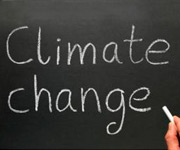One house with solar panels can lead to another, and another …Photo: Mike LinksvayerWhen my husband and I decided to put solar panels on our West Virginia home last year, we thought we might make some waves in our small town, since we would be the first family in the historic district to go solar. Well, it turns out we were right — the panels quickly increased our profile in many ways.
Not only have we produced 2 megawatts (MW) of solar energy (often producing more than we use and therefore feeding back into the grid to power our neighbors’ homes), but we also managed to start a bit of a solar power frenzy in our town.
Inspired by us, one of our neighbors soon installed a solar system three times bigger than ours. Then another neighbor was denied permission to install solar panels, because the town determined they would violate existing historic preservation guidelines. That sparked a larger discussion, still going on today, about whether those guidelines should be changed. The whole town has started to notice and ask questions. The issue created such a buzz that it made the Shepherdstown Chronicle’s list of “10 news stories that characterize Shepherdstown in 2011“:
Historic districts go solar
In April, the Shepherdstown Planning Commission approved a permit for resident Nathaniel Hitt to place photovoltaics on his garage, making Hitt one of the first residents to have solar panels in the historic district. Since last spring, conversation has continued with regard to amendment of rules associated with the allowance of solar panels on Shepherdstown’s historic buildings. Currently the town’s ordinances ban solar panels on the street facing portion of homes, limiting options for residents looking to go solar. In November, the HLC held an informal discussion about the future of solar panels in the historic district, concluding that the Planning Commission and Town Council should take a closer look at the issue.
I can’t tell you how happy this makes me — people are talking about solar power, and nationwide, both solar and wind energy continue to expand as we move beyond coal. Some recent news on that front, according to the Solar Energy Industries Association:
The U.S. solar industry installed a quarterly record for new solar electric capacity in Q3 (2011) with 449 MW. More U.S. solar electric capacity came online in Q3 2011 than all of 2009 combined, and Q4 2011 is predicted to be even larger.
Today, U.S. solar is an economic force: employing more than 100,000 Americans at 5,000 businesses across all 50 states.
Here are three recent examples of solar power installations continuing nationwide:
- The largest active solar project in Texas just came online this month, when Austin Energy powered up a 30-MW solar plant in the village of Webberville, Texas.
- Fort Bliss, a U.S. Army base in Texas, will install a solar energy system expected to save $39 million in energy costs over the next 24 years.
- The public schools in Clinton, Tenn., will install solar panels that will generate not only clean electricity, but also an estimated $118,000 in revenue for the school system every year.
And from the American Wind Energy Association’s review of 2011:
Both Iowa and South Dakota reached the important milestone of 20 percent of their electricity coming from wind power, a first for the U.S. …
According to the latest edition of the U.S. Department of Energy’s Wind Technologies Market Report, turbine prices decreased by as much as 33 percent or more between late 2008 and 2010. …
When more than 50 power plants totaling 7,000 MW unexpectedly went offline in Texas due to unusually cold weather early in the year, wind power was there to help stabilize the system and keep the lights on. Wind energy played a critical role in limiting the severity of the blackouts, providing enough electricity to keep the power on for about three million typical households.
Clean energy is powering more homes and businesses every year, and it’s energizing our economy with new jobs. If we want to keep these trends moving in the right direction, we’re going to have to join together in 2012 to remove obstacles to clean energy.
As just one example, in Virginia, utility giant Dominion has convinced state regulators to approve a surcharge on homeowners with rooftop solar systems between 10 and 20 kilowatts, and they have actively tried to block a large solar project at Washington and Lee University. Removing outdated and misguided barriers like these will be a priority for the Sierra Club and our allies in the year ahead.
As I said before when talking about my own solar panels, it’s an amazing feeling knowing that I am making clean electricity on my own rooftop that does not blow up mountains, cause asthma and heart attacks, spew mercury into the air and water, or leave behind toxic waste. Americans nationwide are feeling the same way as they install solar and wind power at record levels, and 2012 is shaping up to be even better!




